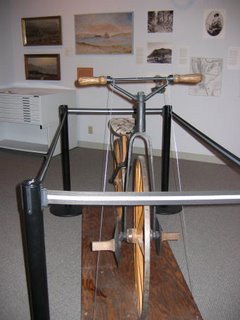
Nevada Historical Society, Reno
Recently, my daughter asked me how Reno got its name. She’d heard two versions of the story; one was that Reno was named after the guy who didn’t show up in time to rescue Custer at the Battle of Little Big Horn, and the other was that the city was named after a Civil War hero.
So, we decided to check out the Nevada Historical Society, located at the north end of the University of Nevada, Reno campus, to see if we could find anything about Mr. Reno.
Founded in 1904, the Nevada Historical Society in Reno is Nevada's oldest museum. Over the years, the society has accumulated an unequaled collection of historic books, writings, photographs and other items about the state.
The Historical Society combines a photo and manuscript library with a small Nevada history museum. A few years ago, the society’s home was renovated and enlarged to accommodate its growing collection of Nevada-related materials.
Once we were inside, my daughter was immediately attracted to the society’s large display of prehistoric Native American artifacts, including rows of handmade Paiute, Washo, and Shoshone Indian baskets and cradleboards.
Many of the baskets are the work of a legendary Washo artist, Dat-so-la-lee, who, in the 19th century, created dozens of magnificent grass baskets with intricate weaves and designs. Because of their quality, some Dat-so-la-lee baskets have been valued at tens of thousands of dollars.
We continued to explore. We found a replica of a Native American grass dwelling as well as exhibits describing Nevada’s mining history.
My daughter found a number of vintage gambling devices that didn’t look like anything she’d ever seen before---strange, mechanical card devices, wooden slot machines, and a big wheel with pictures of dice.
In one corner, we found a couple of antique bicycles with wooden wheels and handle-grips and the most uncomfortable-looking wooden seats.
I told her the story about one thing I recognized, which was an old, stained sack of flour sitting in a display case. The 50-pound sack was originally owned by Austin, Nevada shop owner Reuel Gridley, who, in 1864, lost an election bet and had to carry it through the town.
Following his walk, he auctioned the sack with the proceeds donated to the Sanitary Fund (precursor to the Red Cross). The sack was resold several times that day, generating some $5,000 for charity. Gridley was later asked to repeat the auction in other Western towns and eventually raised nearly a quarter-of-a-million dollars for the Sanitary Fund.
Other displays included a large neon sign from an old Reno bar (“The Phone Booth”) as well as maps, photos and paintings depicting early Nevada, vintage clothing, and beautiful leather saddles and boots.
Of special note is the society's gift store, which offers Native American jewelry, unique history-related gift items and a large selection of books on Nevada.
The Historic Society also publishes an excellent quarterly magazine containing scholarly articles about Nevada history.
The Nevada Historical Society is open Monday through Saturday 10 a.m. to 5 p.m. It is located at 1650 North Virginia Street on the north end of the University of Nevada-Reno campus, adjacent to the Fleischmann Planetarium. For more information call 688-1190.
Oh, we also discovered that Reno is named by the Central Pacific Railroad in honor of General Jesse L. Reno, a Union officer killed in the battle of South Mountain, Maryland in 1862.




No comments:
Post a Comment